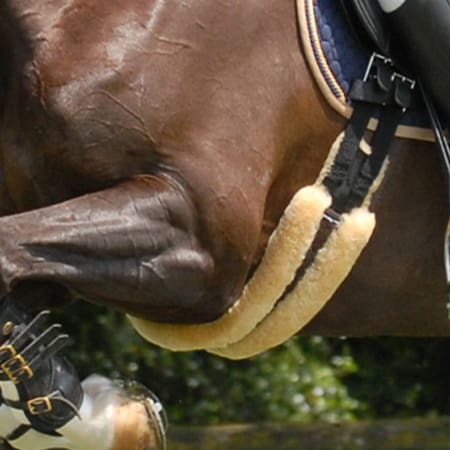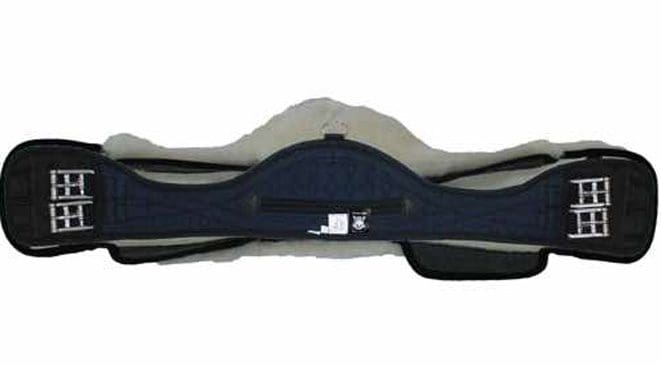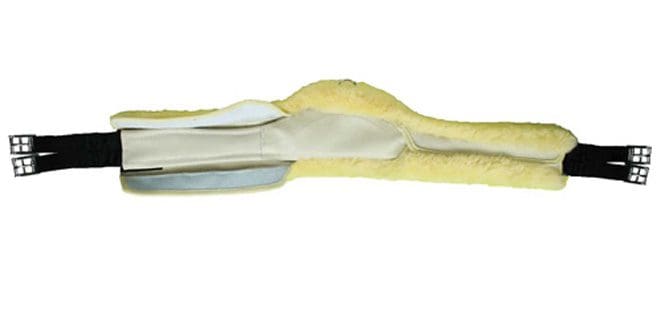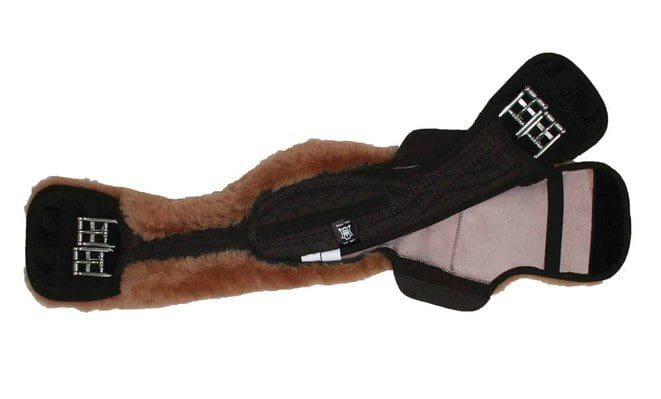
Let’s talk about one of the unsung heroes of horseback riding gear – the horse girth. Sure, it’s not as glamorous as a shiny new saddle, saddle pad or fancy bridle, but this piece of tack plays a crucial role in keeping your horse comfortable and safe during your rides.
A well-fitted girth means a happy horse and a happy horse means a happy ride for both you and your four-legged friend. On the other hand, a poorly fitted girth can lead to some real discomfort and even injuries for your horse, especially if they are particularly sensitive around the girth area and nobody wants that.
There are a bewildering array of girth designs on the market, manufactured from a wide range of materials, but when choosing a girth for your horse, keep in mind that it’s primary role is to keep the saddle securely in place on the horse’s back, preventing the saddle from slipping or shifting during riding.
An effective girth should be comfortable for the horse, but also help to distribute pressure across the horses barrel, allowing for proper movement of the horses shoulders enabling them to move without restriction, pinching, rubbing or chafing.
If you are reading this article, then I assume that you either own a sensitive horse, or have a problem with your current girth. Over the years, the issue of poorly fitting girths and sensitive horses is a topic we get asked about a lot, but we have found very few manufacturers who can tick all the boxes when it comes to producing a girth that is:
A. Comfortable for the horse.
B. Designed to keep the saddle securely in place, preventing slippage.
C. Specially tailored to fit a wide range of horse shapes and issues.
D. Adapted to spread any pressure evenly over the whole girth.
E. Made from natural materials that reduce heat, sweat and rubbing.
We have found only one manufacturer, who ticks all the above boxes and who produce a series of girths designed to accommodate a wide range of horse shapes and sizes as well as deal with specific problems such as sensitive skin, chafing or rubbing, girth galls, etc and that company is E. A. Mattes.
Mattes offers four different designs of girths that fit the majority of horses, whether they have specific issues or simply need a comfortable girth to keep the saddle securely in place. Two of these girths have been specifically adapted to address the needs of sensitive horses, including those prone to rubbing, chafing, and girth galls. We have successfully recommended both types of girths to many customers facing these issues, providing them with effective solutions for their horses’ comfort and well-being.
The Mattes Asymmetric Sheepskin Girth is the perfect girth for horses with sensitive skin or of a delicate nature. Specifically crafted to accommodate a variety of English saddles (and the single buckle version cinch for western saddles), with a significant reduction in the front area to ensure ample space for the elbow and improve clearance. Horses with a less defined girth, a broader rib cage, and a less pronounced or challenging girth groove would also benefit from the Asymmetric girth.

The Asymmetric girth boasts a deeper recess in the elbow region, providing additional clearance and eliminating the possibility of rubbing. Its long and short variants have internal straps that operate in tandem with the horse, evenly distributing pressure across the sternum region and the girth, making the process of girth tightening easier for the horse.

The girth is covered in only the finest Merino Lambskin which is completely removable for ease of cleaning and provides additional cushioning against sensitive and delicate skin. Merino wool fibres are incredibly permeable, allowing air to circulate freely and regulate skin temperature, making it perfect for year-round use. Since lambskin is a natural product, it lowers the risk of skin irritations, sweat problems and rubbing, all areas that can cause your horse to be sensitive in the girth area.

The Mattes girth is available in both long, short (dressage girth) and jumping versions. The long girth is available in girth Sizes: 100cm – 160cm in 5cm Increments, and the short girth is available in girth sizes 50cm – 120cm in 5cm Increments.
The Mattes crescent girth should be used as an anti gall girth and is the best girth for girth sores and horses with ulcers.

The Mattes crescent-shaped girths were also designed to fit barrel-shaped or short-backed horses that have no appreciable girth groove but are also great for horses that have chafing, sores or ulcers in the elbow area, directly where the girth will sit. Many girths don’t give enough room and tend to slip forward exacerbating any problems a horse might have around the elbow area.

The Crescent girth is heavily cut back allowing greater elbow movement without hindrance or the possibility of chafing. The girth opens to the rear in the sides and the rear part is wider than the front so that greater bulk in the rear can be accommodated and this stops the girth from slipping and irritating any existing problems. As with all Mattes standard girths, the base is covered with a quilt fabric material padded with POLY-FLEX® and spreader inserts to optimise the distribution of pressure throughout the girth.

To cushion the horse and prevent further rubbing of existing sores, galls or ulcers, the girth is covered with a thick layer of padding and 100% Merino lambskin incorporating “soft-edge” trim that prevents any pressure on the edges, which helps combat sweating, by soaking up the sweat into the fibres. Being a natural substance the lambskin will not further irritate any skin issues such as ulcers, sores or girth galls, making this one of the best girths for girthy horses. Optional elastic girth straps hold the spring-loaded stainless steel roller buckles as well as provide a little give.
The Mattes Crescent girth is also available in both long, short (dressage girth) or jumping versions. The long girth is available in girth Sizes: 100cm – 160cm in 5cm Increments, and the short girth is available in girth sizes 50cm – 120cm in 5cm Increments.
Pink Equine has been collaborating with Mattes for many years, offering the complete series of Mattes girths to a diverse range of customers. These girths are especially beneficial for horses with specific issues such as sensitivity, slipping saddles, forward girth grooves, and round or barrel-shaped bodies. The quality of Mattes girths is second to none, making them a very sensible investment that, with proper care, will last for many years. Investing in a Mattes girth will pay off repeatedly, resulting in better riding experiences for both you and your horse.
In fact, we are so confident in this brand to sort out any girth problems you may have, that if you complete the free girth consultation form, we will recommend the best girth for your horse and if it doesn’t solve your problems or you are not satisfied with it in any way, we will exchange it for you free of charge.
We are also more than happy to discuss your requirements by telephone, via whatsapp or facebook messaging.
Feel free to browse the complete range of Mattes horse girths (including the Western Girths) here.
For more information regarding sensitive horses and girth issues, please read our Frequently asked questions section below.
A sensitive horse is easily affected by various stimuli in its environment, including touch, sound, and movement. In the context of horseback riding, a sensitive horse may be easily spooked or anxious and may exhibit signs of discomfort or even pain when being tacked up or ridden.
Just like some people who are ticklish in certain areas, some horses may have a naturally delicate disposition or be sensitive to touch in certain areas. However, other horses may have become sensitive due to past traumatic experiences, inadequate training, or physical discomfort.
Girthiness, also known as cinchiness, is a term used to describe a horse’s sensitivity or aversion to having its girth tightened. A girthy horse may show discomfort, agitation, or even aggression when the girth is being fastened or tightened, which can make saddling and riding difficult and unpleasant. Some girthy horses may also exhibit other signs of discomfort, such as bucking, kicking, or biting, and may require special training and handling to address the issue.
Girthiness can be caused by a variety of factors, from poor saddle fit, ill-fitting girths, and underlying health issues, such as skin irritation or girth galls and girth sores as well as traumatic experiences or injury.
Given that each horse’s conformation is different, it can be challenging to establish strict guidelines for correct saddle and girth placement that allows a horse’s freedom of movement while ensuring the saddle is secure for the rider. However, a good rule of thumb is to position the saddle so that it does not rest on the shoulder blade, which can disrupt shoulder movement, and to ensure there is sufficient space between the girth and the horse’s elbow.
Improper saddle placement is a frequent problem among riders. Placing the saddle too far forward is a common mistake that results in the girth passing directly behind the horse’s elbow. The pressure from the girth in this position pinches the muscle, leading to spasms and discomfort for the horse, causing it to become “girthy” or sensitive.
Poorly shaped saddle girths can also cause physical discomfort when tightened, so if your horse seems uncomfortable or resistant during the girthing process, it could be an indication that either the girth or saddle is causing them pain.
Certain horses may be more prone to sensitivity around the girth area due to underlying health issues, such as fungal or bacterial infections, muscle soreness, or digestive problems. These issues can lead to girth galls, girth itch, and other skin irritations, however, these are typically caused by the friction and rubbing of tack, such as saddles or girths, against the horse’s skin.
If your horse shows signs of discomfort or anxiety around the girth area, it may be due to past traumatic experiences. Horses have long memories, and if they have experienced pain or mishandling during saddling in the past, it can lead to ongoing negative reactions. Some types of trauma that may be causing your horse to act girthy include poor training where the girth straps were tightened too quickly, causing discomfort and fear.
Additionally, remembered pain from a previous experience with a too-tight girth, an ill-fitting saddle, an injury, or a digestive problem can be at the forefront of your horse’s memory, causing him to be fearful of the girth. In this scenario, the only solution is careful and gentle retraining your horse to accept a saddle and a girth designed for sensitive horses.
Diagnosing the specific cause of girthiness or sensitive skin in a horse is a careful process of elimination which can make finding the best girth for a girthy horse quite difficult.
A girth gall is a type of sore that can be caused by friction between the saddle or girth and a horse’s body, particularly in areas around the girth or under the saddle. Early signs of a girth gall include raised areas of skin or hair, tenderness when touched or groomed, and pain when the girth is tightened. A horse may show signs of discomfort by trying to bite or move away. Later symptoms of a girth gall may include hair loss, raised weals, skin in the girth area rubbed raw or scabby, often in a wrinkled pattern, and weeping or open wounds.
Girths made of unsuitable materials for a particular type of horse, such as string girths on thin-skinned horses, can cause specific problems. Additionally, dirty, sweat-soaked, worn, or rough girths may also contribute to discomfort for the horse. Tightening the girth too much, especially in young horses being girthed for the first few times, can restrict freedom of movement and also cause skin sensitivity and adverse reactions. Finally, using a nylon girth for extended periods, especially on a sweaty horse, can lead to scalding of the skin.
If left untreated, these girth-related issues can become severe, and the only solution may be to rest the horse until the wounds have healed. When the horse returns to work, it is advisable to use a girth covered or padded with natural fleece or a sheepskin girth to help prevent further irritation and promote healing.
The most critical aspect of a girth’s shape and composition is how well it conforms to your horse’s unique body structure, movements and skin.
1. For maximum comfort, your girth should ensure that pressure is evenly distributed throughout the horse’s body.
2. A girth must move in synchronization with the horse, following the direction of its hair horizontally, rather than against it vertically, thereby avoiding chafing or rubbing discomfort for the horse.
3. A girth that is too narrow can create pressure points in a small area also causing discomfort for the horse.
4. A broader padded girth shaped to curve away from the elbow can significantly improve a horse’s comfort level.
5. The use of real sheepskin padding (not faux fur) will further reduce the risk of inflammation, which is a leading cause of sensitive skin.
Thank you for reading this article! We hope you found it useful!
Please do check out our YouTube channel and subscribe for loads of videos, and advice!
We would also love you to join our community of horse lovers on Instagram and Facebook!